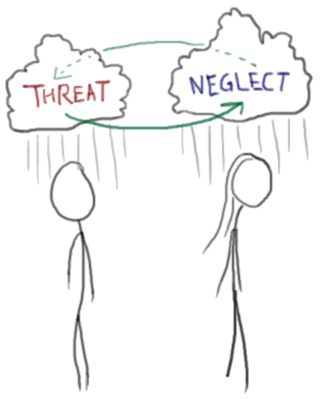Form and content – two levels of change
« Previous Page | 1 2 3 4 5 6 7 8 9 | View All | Next Page »
Untangling Form and Content
The main point here is that our attention is naturally attracted to areas of difference, and as thoughts are embodiments of difference, thoughts take up the majority of our wakeful attention. This means that in general we are more likely to pay attention to the content level than the form level of a given circumstance. In the realm of cognition, the content level is carried by thoughts, while the Form level is at work in thinking, but the difference between content and Form is more general and applies in many other realms.
For this reason, when we don’t make the distinction between content and Form when looking at change, we can easily get confused. This is in part because we carry around various assumptions that, while they may make sense at one level, don’t make sense in the other. In other words, mixing these two levels together when either thinking about or trying to implement change can create and perpetuate misunderstandings, and even exacerbate existing problems. Because it is difficult to be aware of the Formative aspects of a situation, we often carry a vague sense of what is occurring at this level. A common mistake is that we will attempt to solidify the vague feeling by pinning it to something obvious at the content level. This results in a plethora of opportunities for miscommunication.
For example, a recent study (Psychological Assessment, 2010, Vol. 22, No. 2, 288–297) showed that while arguments between married couples had a huge variety of overt sources at the content level (for example, “he forgot to pick up the kids”, or “she criticized my driving”), at the level of Form a common, identifiable pattern could be discerned: one or both partners felt either threatened or neglected. In most arguments the pattern itself (“I feel neglected” or “I feel threatened”) remains implicit and unspoken. When couples’ interactions focus solely on the content level and the level of Form is not explicitly acknowledged, resolutions to the present conflict (“he promises to use his calendar to remember his appointments”, “she will withhold her criticism unless real danger is immanent”) don’t generally prevent the arising of similar conflicts (around different content) in the future. To avoid the pattern of such conflict, it is important to be able to address not just the lower order content, but also the higher order Form(ing). The higher order Forms are the patterns that carry forward the contexts out of which the lower order content precipitates. In this example, what is called for is some attention to the issue at a higher level: the feelings of threat or neglect.
Perhaps this distinction between content and form seems obvious. It may be so when pointed out, but it requires some significant effort to get into the habit of making this distinction–and what’s more important, making the distinction at the appropriate time. And even then, making the distinction is only the first step; we must be able to act differently upon the basis of the perceptions that are possible once the distinction has been made. It is not enough to simply be aware of the pattern; indeed there is a danger that this can exacerbate the issue. The crux of the issue about change revolves not around having some new knowledge (about higher order processes), but about learning to know differently, to actually change the higher order processes themselves.
« Previous Page | 1 2 3 4 5 6 7 8 9 | View All | Next Page »






Firstly, my sympathies.Secondly, maybe a lttile hope. As you know I plunged in to this world of “EdTech” rather late – and it’s been my observation that most of the people writing about EdTech are no longer writing about EdTech at all. The interesting ones are writing about culture, society and life. EdTech is just an increasingly bare frame to hang more interesting ideas on. The interesting folks add insight, the duller ones platitudes and clunking rhetoric but the framework is no longer important. With your brain and your cross-disciplinary magpie-ism you could find a home in any academic discipline. Of that I am sure.